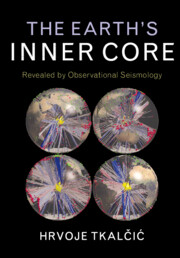Book contents
- Frontmatter
- Contents
- Preface
- Acknowledgements
- 1 On the History of Inner Core Discovery
- 2 Seismological Tools to Study the Inner Core
- 3 Inner Core Surface and Its Interior
- 4 Inner Core Anisotropy
- 5 Inner Core Rotational Dynamics
- 6 The Limitations, the Obstacles, and theWay Forward
- Appendix A Transmission/Reflection Coefficients for the Flat Inner Core Boundary
- Appendix B The Angle Between PKIKP Waves and the Rotation Axis of the Earth
- Appendix C P-Wave Velocity in a Transversely Isotropic Inner Core
- Appendix D Transdimensional Bayesian Inversion
- References
- Index
- Plate section
4 - Inner Core Anisotropy
Published online by Cambridge University Press: 26 January 2017
- Frontmatter
- Contents
- Preface
- Acknowledgements
- 1 On the History of Inner Core Discovery
- 2 Seismological Tools to Study the Inner Core
- 3 Inner Core Surface and Its Interior
- 4 Inner Core Anisotropy
- 5 Inner Core Rotational Dynamics
- 6 The Limitations, the Obstacles, and theWay Forward
- Appendix A Transmission/Reflection Coefficients for the Flat Inner Core Boundary
- Appendix B The Angle Between PKIKP Waves and the Rotation Axis of the Earth
- Appendix C P-Wave Velocity in a Transversely Isotropic Inner Core
- Appendix D Transdimensional Bayesian Inversion
- References
- Index
- Plate section
Summary
“The progress of science has always been the result of a close interplay between our concepts of the universe and our observations on nature. The former can only evolve out of the latter and yet the latter is also conditioned greatly by the former. Thus in our exploration of nature, the interplay between our concepts and our observations may sometimes lead to totally unexpected aspects among already familiar phenomena.”
Tsung-Dao Lee, Nobel Lecture (Lee, 1957)Introduction to Seismic Anisotropy
Seismic anisotropy is a physical property of the Earth that describes the directional dependence of various seismic parameters, such as the velocity and attenuation of seismic waves. Today, it is generally accepted that some form of seismic anisotropy is present in the IC, in a similar way that it is in the Earth's crust and mantle, and in laboratory conditions under high temperatures and pressures, where it can be more directly examined.
Unsurprisingly, anisotropy is a widespread phenomenon encountered in nature and, therefore, in many fields of science andmeasurement techniques. For example, it occurs in the orientation of the magnetic field in plasmas, the growth of leaves, heat conduction, the random motion of water molecules in the brain, the formation of sediments, and the growth of crystals. We also encounter anisotropy across various branches of technology, such as spectroscopy, filtering, optics, sheet metal forming, and ultrasound imaging, among many other techniques.
The course of development of the IC anisotropy concept contains all elements normally present in a scientific process, where observations first lead to questions that then demand answers. The first and foremost question at the root of our fascination with IC anisotropy, “Is IC anisotropy the real mechanism behind seismological observations?”, is a driving force for a number of seismological studies. Another relevant question, “If there is IC anisotropy measurable by existing seismological techniques and spatial coverage, how widespread and large is it?”, naturally follows the first question. Consequently, many geoscientists wonder: “What is the physical mechanism behind IC anisotropy, and what can it tell us about the dynamics and history of our planet, how it formed, perhaps even how the geomagnetic field came to its existence and how it evolved?”
- Type
- Chapter
- Information
- The Earth's Inner CoreRevealed by Observational Seismology, pp. 74 - 130Publisher: Cambridge University PressPrint publication year: 2017



